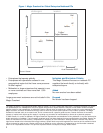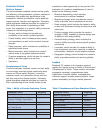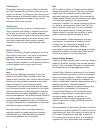
7
Evaluation Criteria Definitions
Ability to Execute
Product/Service: Core goods and services offered by the vendor that compete in/serve the defined market. This
includes current product/service capabilities, quality, feature sets, skills, etc., whether offered natively or through OEM
agreements/partnerships as defined in the market definition and detailed in the subcriteria.
Overall Viability (Business Unit, Financial, Strategy, Organization): Viability includes an assessment of the overall
organization’s financial health, the financial and practical success of the business unit, and the likelihood of the individ-
ual business unit to continue investing in the product, to continue offering the product and to advance the state of the
art within the organization’s portfolio of products.
Sales Execution/Pricing: The vendor’s capabilities in all pre-sales activities and the structure that supports them.
This includes deal management, pricing and negotiation, pre-sales support and the overall effectiveness of the sales
channel.
Market Responsiveness and Track Record: Ability to respond, change direction, be flexible and achieve competitive
success as opportunities develop, competitors act, customer needs evolve and market dynamics change. This criteri-
on also considers the vendor’s history of responsiveness.
Marketing Execution: The clarity, quality, creativity and efficacy of programs designed to deliver the organization’s mes-
sage in order to influence the market, promote the brand and business, increase awareness of the products, and estab-
lish a positive identification with the product/brand and organization in the minds of buyers. This “mind share” can be driv-
en by a combination of publicity, promotional, thought leadership, word-of-mouth and sales activities.
Customer Experience: Relationships, products and services/programs that enable clients to be successful with the
products evaluated. Specifically, this includes the ways customers receive technical support or account support. This
can also include ancillary tools, customer support programs (and the quality thereof), availability of user groups, serv-
ice-level agreements, etc.
Operations: The ability of the organization to meet its goals and commitments. Factors include the quality of the orga-
nizational structure including skills, experiences, programs, systems and other vehicles that enable the organization to
operate effectively and efficiently on an ongoing basis.
Completeness of Vision
Market Understanding: Ability of the vendor to understand buyers’ wants and needs and to translate those into prod-
ucts and services. Vendors that show the highest degree of vision listen and understand buyers’ wants and needs,
and can shape or enhance those with their added vision.
Marketing Strategy: A clear, differentiated set of messages consistently communicated throughout the organization
and externalized through the Web site, advertising, customer programs and positioning statements.
Sales Strategy: The strategy for selling product that uses the appropriate network of direct and indirect sales, market-
ing, service and communication affiliates that extend the scope and depth of market reach, skills, expertise, technolo-
gies, services and the customer base.
Offering (Product) Strategy: The vendor’s approach to product development and delivery that emphasizes differenti-
ation, functionality, methodology and feature set as they map to current and future requirements.
Business Model: The soundness and logic of the vendor’s underlying business proposition.
Vertical/Industry Strategy: The vendor’s strategy to direct resources, skills and offerings to meet the specific needs
of individual market segments, including verticals.
Innovation: Direct, related, complementary and synergistic layouts of resources, expertise or capital for investment,
consolidation, defensive or pre-emptive purposes.
Geographic Strategy: The vendor’s strategy to direct resources, skills and offerings to meet the specific needs of
geographies outside the “home” or native geography, either directly or through partners, channels and subsidiaries as
appropriate for that geography and market.









